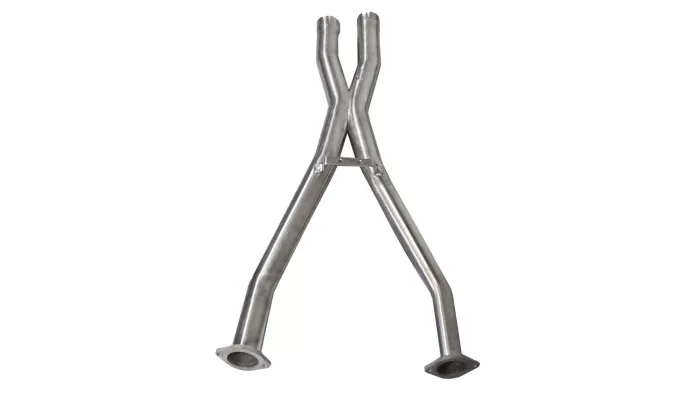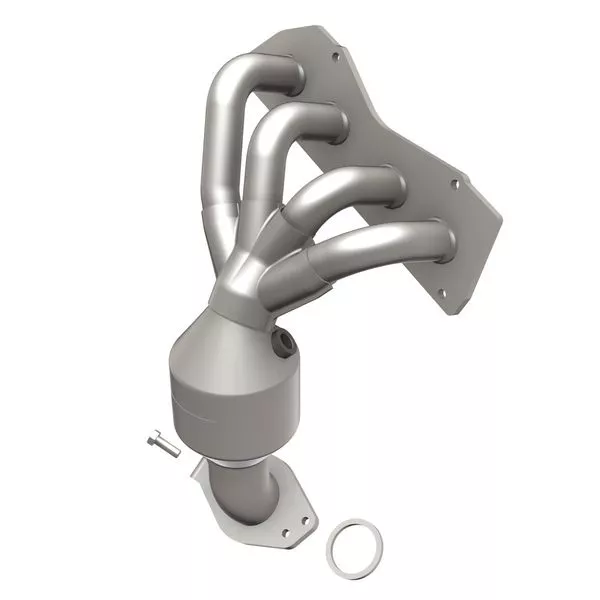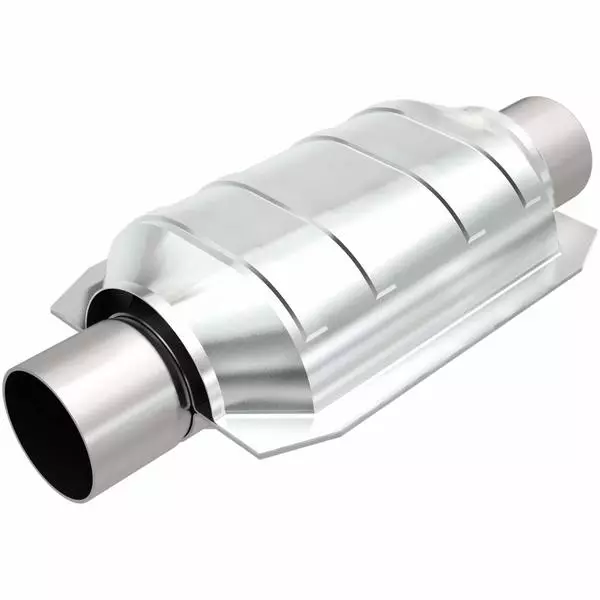When installed, the only part of the exhaust system you get to see is the tailpipe which usually protrudes past the rear bumper.
But it is not the only component of the exhaust system.
Being multi-purpose, exhaust systems usually consist of more than 5 components.
Each of these components performs specific functions which are vital for the performance of the entire system.
The system begins immediately after the combustion box, all the way to the tailpipe.
Below is a break down of all the parts and the tasks they perform.
Exhaust pipes and tubing
This makes the major part of the exhaust system as it connects all the parts to each other.
The exhaust pipe is used for the flow of the exhausts from the moment they are released out of the combustion chamber to the point they exit the system.
After each step, there is always an exhaust pipe to carry the exhaust gases to the next process.
To prevent any chances of corrosion or rusting, the exhaust piping is usually made of stainless steel or aluminized steel.
In a few instances, they are made of plain steel which is less resistant to corrosion.
Exhaust manifold
This is the first point the exhaust gases pass through before even getting to the piping system.
The exhaust manifold connects to the cylinders through different ports and uses flange connectors and gaskets to do so.
It carries the gases away from each exhaust cylinder head and channels them into a single outlet which is the exhaust pipe. From there they are poured into the catalytic converter.
The exhaust manifold is usually made of cast iron or stainless steel.
Most manufacturers prefer the cast iron for exhaust manifold as it is affordable and easy to use.
Stainless steel is preferred because it is resistant to rust and corrosion and can withstand toxic emissions.
It is also insulated to accommodate the high temperatures of the exhaust gas without transmitting it to the other parts.
Oxygen sensor
The oxygen sensor has a significant impact on your vehicle’s fuel economy and efficiency.
The component is mostly found in the exhaust systems of modern vehicles. They use it to test the amount of oxygen in the mixture of exhausts as they leave the combustion chamber. They also test the level of oxygen leaving the catalytic converter.
After testing, the information is sent to the vehicle’s computer. The computer will then add or reduce the fuel intake of the engine accordingly.
This will help maintain good performance and prevent fuel wastage, hence better fuel economy.
An exhaust system can have more than one oxygen sensor. One is usually placed on or near the exhaust manifold while the other after the catalytic converter.
An oxygen sensor can also help determine if your catalytic converter is bad. In most cases, it will give a p0420 code but a definite diagnosis is needed to determine if the problem is really with the catalytic converter or something else.
Catalytic converter
The catalytic converter comes in a muffler-like design and it is one of the most crucial parts of the exhaust system.
As your car’s engine is running, it spits out exhaust fumes that have adverse pollution to the environment. The catalytic converter acts as the filter and cleans up the exhaust gas.
What are these gases?
The emissions from the vehicle’s engine are usually a mixture of nitrogen oxide, carbon monoxide, carbon dioxide, nitrogen, unburned fuel, water vapor, hydrocarbons, and oxygen.
Carbon monoxide, nitrogen oxide, and hydrocarbon gases are very toxic and corrosive.
If emitted into the air, they cause air pollution which can lead to serious health problems for the people around them.
Similarly, if they are left unreleased, they can be harmful to you as the driver and the other vehicle occupants as well as the engine.
The emissions are thus converted into less harmful gases, that is water vapor and carbon dioxide, before being released out.
The conversion is in form of chemical reactions, and it happens in the catalytic converter.
But, in order for the reactions to happen, there have to be catalysts, which in most cases are special metals. These are contained inside the catalytic converter and held in place by the ceramic which also keeps them hot for the job.
Speaking of, a catalytic converter has to be hot in order to perform its task. Because of this, it takes between 10-15 minutes before it starts converting as it still builds up heat.
During these first few minutes, your car’s engine will still emit some unconverted gases into the environment.
The catalytic converter is mounted after the exhaust manifold and right before the resonator and muffler.
Muffler
Also called a silencer, the exhaust muffler is the second most crucial part of the exhaust system. It is responsible for reducing and shaping the engine sound waves.
Besides the gases, your vehicle’s engine also produces exhaust noises. The exhaust noises are a result of the explosive processes in the combustion box. Additionally, the engine creates vibrations that affect the body of the vehicle.
The noises are not only harmful to the environment and your vehicle but they are also illegal.
The exhaust noises thus need to be reduced to an acceptable level, or at least shaped to sound aggressive but not annoyingly loud.
The exhaust muffler usually uses either baffles or fiberglass packing for handling the noise.
The fiberglass packing reduces noise by absorbing it while the baffles bounce back the noise.
For a throaty and aggressive sound, most sporty cars have two mufflers. One of the mufflers, usually the bigger one, is for quieting the noise while the smaller one shapes it to sound aggressive but not annoyingly so.
To prevent pressure from building up inside the mufflers, you can have a double exit muffler.
This is when the muffler splits into two tailpipes and the gases are released through these two tailpipes.
Resonator
The resonator is a minor component of an exhaust system, but a vital one. They are usually in the form of straight pipes and contain sound muffling materials.
The resonator acts as bounce chambers for sound waves and help to quiet the exhaust noises. They can do this before the exhaust gets into the muffler or as they flow out.
For this reason, the resonators are usually located before the muffler and sometimes after the muffler.
Some exhaust systems may lack the resonator but still be able to perform well, the effect however, will be on the sound.
How does performance and sound relate in the exhaust system?
Interestingly, the components of an exhaust system work together, but can sometimes affect each other. For instance, the muffler and the resonator affect the horsepower of an exhaust system.
As bizarre as it may sound, the quieter your car, the less horsepower its engine has. This is because the muffler and the resonator force the exhaust flow on a specific path. This causes restrictions, hence less power.
While a vehicle can operate without a muffler, it is not recommendable, or even legal. Driving without a muffler can cause deafening noise which is not healthy for you or the people around.
Tailpipe
This marks the end of the exhaust system through which the gases are released out.
It is the only visible part of the exhaust system and sometimes it ends in a straight pipe or has a modified tip.
The tips are often of stainless steel or coated to protect them from rust by elements like road salt and excess moisture.
The tailpipe also helps reduce pressure in the system, hence it has a bigger diameter than the rest of the pipes.
While most vehicles have single exhaust systems and tailpipes, sportier cars tend to have more than one.
This is where the difference between dual exit and dual exhaust comes in
Difference between a dual exit exhaust and a dual exhaust system?
Some vehicles are fitted with double exhaust systems to help improve the horsepower even more. This means the emissions will be deposited into different exhaust manifolds.
This goes till the end with the gases passing through different mufflers as well as catalytic converters. They are also channeled out using different tailpipes.
You can even go the extra mile to have your mufflers within the dual exhaust system, splitting into two tailpipes.
The system thus becomes a dual exit exhaust system within a dual exhaust system.
Dual exit exhaust system on the other hand has just a single exhaust system. The cylinders deposit the gases into a single exhaust manifold but the gases are channeled out using two different tailpipes.
This helps to prevent pressure build-up in the muffler and it helps improve gas output.
But it does not affect how the engine outputs air. Thus, it has no significant impact on the engine’s power and performance.
Other minor parts of the exhaust system include the gaskets, connection flanges, clamps and welds which are used for proper sealing of the parts.
All the components of an exhaust system; from the exhaust manifold to the tail pipe are coated to or made of stainless steel. This is to protect them from elements like road salt that can cause rust and corrosion.




